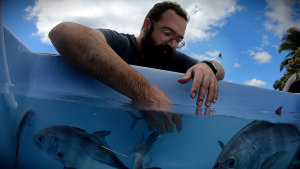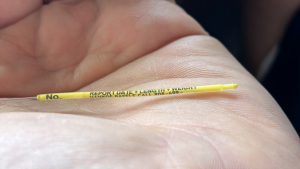The number of fish to catch around Oʻahu got a small boost when a team including University of Hawaiʻi at Mānoa researchers released about 150 tagged pāpio (juvenile ulua or giant trevally) into waters around the island. Now, fishermen can help those researchers with important data by catching the tagged fish and reporting the information while also winning prizes. Fishermen can keep all of the pāpio they catch.
The pāpio were released on October 17–19 at four different locations around Oʻahu: Waikīkī Aquarium, Kāneʻohe Bay, Pūpūkea Marine Life Conservation District and Pōkaʻī Bay.
Researchers hope to show on a small scale how raising and releasing the pāpio could offset fishing pressure and help rebalance the composition of the local reef fish populations if done on a larger scale in the future.

“What I hope this project achieves is bringing awareness to the concept of restorative aquaculture,” said Spencer Davis, a PhD student at UH Mānoa’s Hawaiʻi Institute of Marine Biology (HIMB) and an employee of Oceanic Institute of Hawaiʻi Pacific University. “That fish can be grown from eggs collected from public aquariums and that those fish can be used to restore populations of wild fish.”
Researchers included four release sites around the island to mitigate any concerns about predator introduction or genetic impact. In addition, throughout the rearing to release process best management practices were integrated to mitigate any biosecurity issues. By releasing smaller cohorts of approximately 50 pāpio around Oʻahu, they hope to increase the number of fishermen that will have access to catch the fish later and gather recapture data. Each release site is located in regulated areas to allow time for the fish to acclimate to the wild before moving out into fishable zones.
“These releases provide a small enhancement to wild populations of ulua around Oʻahu with the intent to both restore the ecological structure of coral reef fish communities and provide recreational opportunities to local fishers,” said Erik Franklin, an associate research professor at HIMB and Davis’ advisor. “We’re planning to expand this program if we can identify future funding support.”
Partnering with local fishermen

Each tag is labeled with a unique fish identification number and a note instructing fishermen to call the researchers and report the date, capture location (general area, no need to give away your secret spots), length and weight of the fish. Nanko’s Fishing Supply is supporting the project with a raffle and prizes for participating fishermen at the end of the recapture period, approximately one year after the pāpio are released.
“We would love to find any of these released fish that end up being recaptured and reported by local fishermen,” said Davis. “We would learn about how much the fish grew in the wild, how far it traveled from the release location, and how likely fishermen are to recapture fish that are released as part of similar restorative aquaculture efforts.”
Originally, researchers received eggs from Maui Ocean Center in November 2022 and grew the eggs into the pāpio being released today. Franklin contributed funding provided by a local donor who supports research on recreational fishing to the UH Foundation for tagging the fish and transporting them for release.

Looking to future large scale efforts
A healthy ecosystem is composed of many species fulfilling key ecological roles such as predators, herbivores and scavengers. Fishing pressure has led to a decreased number of apex predators in waters around the main Hawaiian islands, especially Oʻahu. If any of the pāpio are recaptured, it will help researchers learn about how effective a larger scale restorative aquaculture effort can be in the future.
This project is a spin-off of previous work funded by the Center for Tropical and Subtropical Aquaculture. This collaboration includes efforts from: Waikīkī Aquarium; Department of Aquatic Resources; HIMB; Oceanic Institute of Hawaiʻi Pacific University; and Maui Ocean Center.
If you support this initiative and want to see more projects like this happen, please contact Davis at sbdavis@hawaii.edu or (808) 699-9991 to receive a brief survey to indicate your interest.

